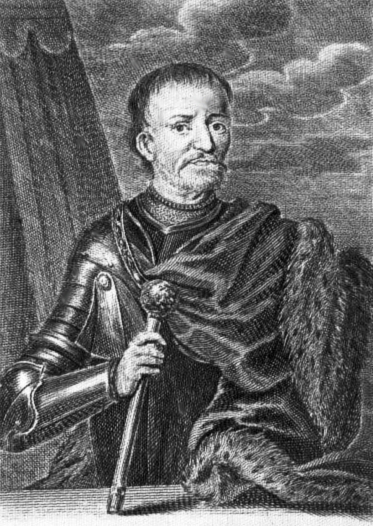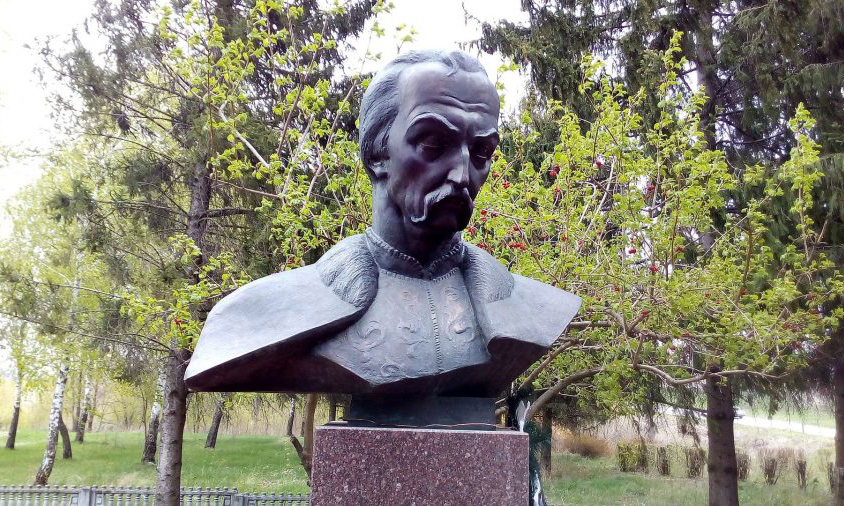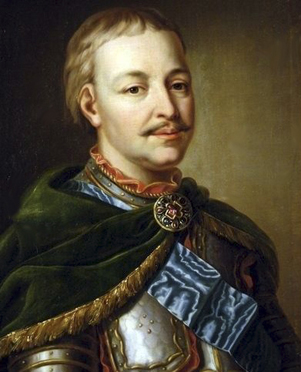(Russian Historical Stereotypes and We Dispel Them)
Ivan Mazepa, unknown artist, 1700, Dripropetrovsk Art Museum.
Until the 20th century, Ivan Mazepa has been the most scorned Ukrainian from the Russians point of view. He has been depicted as the betrayer whose deeds were lead by the own vested interests and as if they were more important to him than the destiny of the Ukrainian nation. During the period of the 18th - 20th centuries, all those Ukrainians who approved of Ivan Mazepa’s decision were called mazepyntsi.
In the history falsified by the Russians, Ivan Mazepa was the most criticised and portrayed in the darkest colours. These intensive efforts in compromising his name are directly related to the fact that Ivan Mazepa was trusted by Peter I. Moreover, by the nature of his attitudes and values, the political culture, education and upbringing, Ivan Mazepa was a typical European while Peter I with his “all-drunk councils”, wild orgies and bloody massacres resembled the barbarian. Due to the mentioned, the stereotype of the betrayer hetman as the embodiment of all the evil was eagerly developed and spread.
Both the predecessors (even I. Brukhovetskyi) and the successors (K. Rozumovskyi or K. Razumovsky) of hetman Ivan Mazepa considered that Hetmanate was a self-sufficient state embracing only the Ukrainian ethnic lands and was a subject of the international law. However, it was I. Mazepa who openly spoke out against Muscovy and these deeds were generating the hostile attitude of the Muscovite authorities.
When Ivan Mazepa became a leader in Hetmanate in 1687, the Ukrainian state had been recognised as independent by many other states in Europe. Hetmanate had the own financial and legislative systems, customs, administrative and territorial division, nobility and the ruler (hetman). Formally, the Moscovian state and Hetmanate were united by the tsar, who was recognised as the overlord by the hetman on the grounds of the 1687 Kolomak Articles. At the lifetime of Mazepa, the relations between Russia and Ukraine underwent the legal norms of that epoch: the subordination to the other leader was based on the agreement and there also were the legal grounds to abandon such protection. If an overlord had violated those rights and freedoms of a subordinate which were determined in the dedicated agreement, the latter was regarded as one who was free from any obligations to such an overlord.
Further, it worth noting that the contemporaries of Mazepa were also in a search for the ways of the better destiny for their states. In particular, Johann Reinhold von Patkul, the leader of Livonian nobility, was in pursuit of eliminating the Swedish power over Livonia and saw the way out in the rebellion to burst out in 1689 via the assistance of Augustus II, the Polish king, and Peter I, the Russian tsar. The next illustrative example is Stanisław I (Stanisław Leszczyński), the Polish king, who tried to protect the “golden freedoms” of the Polish noblemen from the advancing Saxony absolutism at the end of the 17th century and the beginning of the 18th century. Here, we should mention the efforts of Ferenc II Rákóczi, the leader of the Hungarian nobility, who was trying to abandon the power of the House of Habsburg in Hungary in 1708 through the assistance of France. Dmitry Kantemir (Dimitrie Cantemir), the lord of Moldavia, was enjoying the support of Peter I in his efforts to refuse the control of the Ottoman Empire in 1711.
Also note, Dmitry Kantemir, who acted as a betrayer towards the Ottoman sultan, was not regarded as one by Peter I since this betray was in favour of Muscovy. Returning to Mazepa’s case, from the very beginning of his hetmanship, Ivan Mazepa set the main objective of his activities: the enhancing of the Hetmanate sovereignty. The evidence of this is the text of the new agreement, concluded in Moscow in 1689.
 The Ukrainian nobility at Mazepa’s ruling managed to summarise the previous experience and justify the legitimacy of Hetmanate, rejecting the Moscow's claims for the Kyiv heritage. In 1698, Pylyp Orlyk made a trial to search the Ukrainian history traces within the Troy epoch.
The Ukrainian nobility at Mazepa’s ruling managed to summarise the previous experience and justify the legitimacy of Hetmanate, rejecting the Moscow's claims for the Kyiv heritage. In 1698, Pylyp Orlyk made a trial to search the Ukrainian history traces within the Troy epoch.
Later, in the Constitution dd 1710, the Ukrainians were claimed to be descended from the Khazars who conquered Rus and accepted Christianity afterwards. Then, the Cossack folk was captured by the Polish but managed to free themselves during the times of Bohdan Khmelnytsky and voluntarily took the protection of the Muscovy tsar or “took his hand”. Eventually, the history of the Ukrainians is older than that of the Muscovites. Two nations originated from the different ancestors. Therefore, there were no legal rights for the tsar to possess Ukraine. I. Mazepa was compared to Volodymyr the Great, the prince of Rus.
The quotation “Kyiv is the second Jerusalem” was actively spreading. Mazepa’s politics was carried out in a way to show the Moscovian state what the favours of the stable development of Hetmanate are. All the diplomatic negotiations with the Ottoman Empire, the Crimean khanate and the Principality of Moldavia were conducted through Ivan Mazepa. That was the way of restoring the sovereign entity of Hetmanate in the sphere of international relations.
During the periods when Mazepa was making the own decisions on the domestic and foreign policies, there were no needs even to think of the release from the Moscow control. The status of Hetmanate had changed drastically after the beginning of the Second Northern War in 1700, which was initiated by the Moscovian state. Peter I started to intrude into the Hetmanate’s sovereignty and this made Mazepa apply to the legitimate right and refuse this overlord protection. The reorientation of the tsar from the South into the North direction excluded any need in the influential hetman power. Actually, Hetmanate’s role narrowed into the supplier of the resources and human force for the military campaign. The period of 1701-1703 was the first time when the Cossack regiments were in the military expedition under the Russian officers’ command. Since 1700, several decrees (ukazy) of the tsar had been issued and they were destroying the Ukrainian economy while A. Menshikov, the favourite of Peter I, was threatening that he would liquidate Hetmanate and bring the Russians to those lands for the permanent residence. In 1708, the Muscovites made the forced changes in the administrative division of Ukraine and introduced Kiev governorate. This turned Ukraine into a typical province of Muscovy.
The final decision of Mazepa was pushed by the tsar’s refuse to protect Ukraine from the Swedish army that was the flagrant violation of the obligations taken by the overlord. Moreover, Peter I promised the Kyiv Principality to Duke of Marlborough in exchange into the assistance in the war against the Swedish. Such attitudes and deeds of the tsar allowed the legal release of Hetmanate from the Russian protection.
In Europe, the most of people were sure that the Swedish king would gain the victory. In such cases, the nobilities of the nations tried to be way ahead of the game and swore allegiance to the potential winner, which was quite a chance for restoring the original rights under the power the new overlord. All the dependent rulers were worrying about the interests of the own states but not about the rescue of the unjust overlord. This story is similar to one of Denmark and Rzeczpospolita. Thus, all the facts evidence that Ivan Mazepa neither engaged any intrigues nor betrayed the tsar who had trusted him too much. Actually, taking the side of Swedish Charles XII (Karl XII) in 1708 was a logical step in the number of effort to protect the original interests.

The current article relies on the open source information and quotes the book by V. Brekhunenko (Брехуненко В.А. Війна за свідомість. Російські міфи про Україну та її минуле.‒ Київ, 2017.‒ 280 с.)
Our Advice to Read:
Єнсен А. Мазепа. Історичні картини: [історична монографія] / пер. зі швед. Н.Р. Іваничук.– Харків: Фоліо, 2020.– 183 с.: іл.– (Великий науковий проєкт).
Журавльов Д. Іван Мазепа: людина, політик, легенда.– Харків: Фоліо, 2020.– 348 с.: іл.– (Великий науковий проєкт).– Бібліогр.: с. 343–347.
Лепкий Б. Мазепа: роман-трилогія.– Донецьк: БАО, 2015.– 480 с.
Оглоблин О. Гетьман Іван Мазепа та його доба.– Репр. вид.– Київ: Центр учбової літератури, 2020.– 406 с.: іл.
Таїрова-Яковлєва Т.Г. Іван Мазепа / пер. з рос.: Ю.А. Мицик, І.Ю. Тарасенко.– Харків: Фоліо, 2018.– 315 с.: фот., іл.– (Великий наук. проєкт).
Чемерис В.Л. Трагедія гетьмана Мазепи: роман-есе.– Харків: Фоліо, 2015.– 475 с.
Шевчук В. Просвічений володар. Іван Мазепа як будівничий Козацької держави і як літературний герой.– Київ: Либідь, 2006.– 464 с.
***
Тесленко Л. «Тепер ми знаємо, як виглядав Мазепа». Невідомі сторінки життя й боротьби великого гетьмана // https://novynarnia.com/2019/03/20/380-richnyj-mazepa/
Our Advice to Watch:











